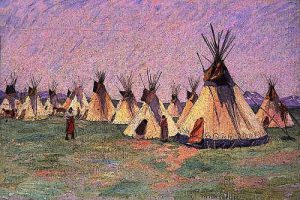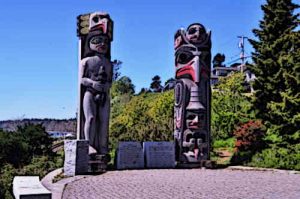Native American Facts
Native Americans refer to such people who have been living in the present-day United States for thousands of years. They were already living in North America when Columbus discovered the American continent in the late 15th century.
Native Americans lived as various tribes, occupying different territories all over North America. When Europeans arrived in America, the Native American tribes were slowly pushed out of their territories.
They fought many wars with British colonists as well as with the American armies after USA came into being. A large number of Native Americans still live in USA today.
Facts about Native Americans:
Native Americans lived as tribes. The most famous and largest of these tribes included Cherokee, Mohawk, Apache, Navajo, Chippewa, Iroquois, Lumbee and Pueblo. Each tribe had its own chief. Sometimes, many tribes formed political alliances and chose a common leader.
American Indians lived in different types of houses. These included tepees, chickees, wigwams, and brush shelters. They mostly used wood, grass, and other natural materials in constructing their homes. The tribes who were often on the move usually lived in tepees. It was easy to make a tepee and then dissemble it when the tribe had to move.

Tepees on the Prairie 1902
Many Native American tribes hunted bison and other animals in order to provide food for the tribe. They often moved around to keep track of the animals and stay close to them in order to hunt them. For this reason, they didn’t have permanent homes or towns.
Some Native American tribes relied on farming and agriculture. The most common crop was maize although they also grew beans, squash and other crops. Women also played an important role in cultivating and harvesting the crops.
The Chickasaw, Cherokee, Choctaw, Seminole and Creek tribes were termed as the ‘Five Civilized Tribes’ by the European colonists. This is because these tribes lived in fixed places like villages and even had a written language of their own.
Totem poles were built by Native American tribes who lived in Northwest America. They built these poles in front of their houses to show off their family status or to commemorate the memory of a deceased ancestor.

Native American Indians totem poles
The total population of the Native Americans in the late 15th century was around 2 to 18 million. Once the white Europeans arrived, disease and warfare ravaged the Native American tribes. By the beginning of the 20th century, there were only 250,000 Native Americans left in USA.
When the Europeans arrived in North America, there were no horses. The Native American tribes traded horses for different goods they supplied to the Europeans.
They learned to ride very quickly and before soon, they were expert riders. They also developed new breeds of horses, some of which exist today.
The arrival of Europeans began many problems for the Native Americans. They were exposed to diseases which were common in Europe but didn’t exist in North America.
As a result, they died in huge numbers. Their populations also suffered due to a number of wars with the European settlers.
In 1876, thousands of Native Americans fought against the US army at the Battle of Little Big Horn. The US army wanted to remove and relocate them while the Native Americans resisted this.
The ensuing battle resulted in heavy losses for the US army and a victory for the Native Americans. The battle was also the scene of the famous Custer’s Last Stand.
In 1830, US Congress passed the Removal Act. This Act said that the Native Americans should be removed from Southeast United States to modern-day Oklahoma. More than a 100,000 Native Americans were forced to undergo this relocation.
They had to travel thousands of miles from their home to the new reservation site in Oklahoma. Thousands of Native Americans died along the way due to hunger, fatigue and lack of adequate resources.
They didn’t have animals or transport vehicles, so the men, women and children had to walk most of the journey on foot. This journey famously became known as the Trail of Tears.
In 1890, the Battle of Wounded Knee took place. This battle was fought between the US army and Native Indians of the Sioux tribe. The battle resulted in a complete victory for the US army and became the last major military engagement with the Native American tribes.
During the late 19th century, there was a spiritual revival among the Native American tribes. They believed that they had suffered disease and defeat at the hands of the white settlers because they had become distant from their spiritual beliefs. So a movement started which said that Native Americans should get in touch with nature. Ghost Dance was a part of this movement.

Ghost Dance of Native American Indians
One of the most famous Native American figures was Pocahontas. She lived from 1595 to 1617. During this period, her tribe came into contact with British settlers. Pocahontas played an important role in helping out the white settlers who had to face harsh conditions. She eventually married one of the white settlers, John Rolfe, and visited London.
Sitting Bull was another most famous Native American in the American History. He belonged to the Lakota tribe and was one of the leaders in the Great Sioux War of 1876. He led the Lakota tribe to a major victory against the US army at the Battle of Little Bighorn.
The name of many US states come from Native American terminology. For instance Alabama is derived from ‘Alibamu’ which means ‘those who clear land for agriculture.’ Similarly, Arizona is derived from ‘arizonac’ which means ‘little springs.’ Iowa means ‘sleepy ones’ and is derived from the name of one of the Native American tribes.
One of the Founding Fathers of USA, Benjamin Franklin, drew inspiration from the confederate form of government practiced by the Iroquois tribe. He believed that such a democratic form of government should be practiced by the English colonies in North America.
- Native America
- Famous Native Americans
- Native American Art
- Native American Clothing
- Native American Definition
- Native American Facts
- Native American Food
- Native American Gods
- Native American History
- Native American Houses
- Native American Indians Lives
- Native American Life
- Native American Names
- Native American People
- Native American People Roles in Society
- Native American Symbols
- Native American Timeline
- Native American Tribes
- Native American Warriors
- Native American Wars
- Symbol for Strength
- Totem Poles
- Who were the Native American people?
- Why were they called Red Indians?
- Wigwams